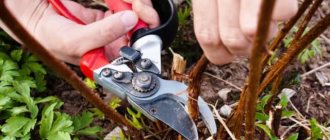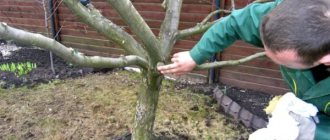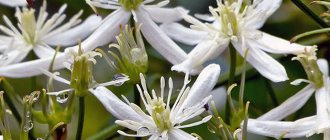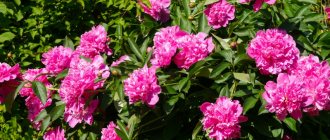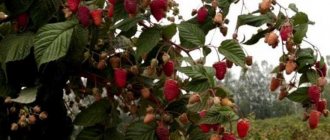Features of pre-winter care
As part of autumn care, standard procedures are carried out for all fruit bushes, which include proper pruning, application of nutrients, watering and treatment against pests and diseases.
Bush pruning
The basis of autumn pruning of currant bushes is the cleaning and removal of all excess branches with shoots. At the same time, the formation of the correct crown is carried out. This procedure helps to increase crop productivity and extend the fruiting period.
The timing of pruning depends on the type of currant. For example, black ones need to be pruned immediately after harvesting, white and red ones - in the fall, when the dormant period begins.
Regardless of the varieties and types of currants, before winter pruning is carried out according to the same scheme:
- Using sharp garden tools, remove all injured, broken branches with shoots that show signs of disease or pest damage.
- Trim off all thin and weak shoots if they have a small number of branches.
- Also remove old branches - they are thick and have a darker shade of bark than young ones, they may even be black.
- Trim all branches that grow into the center of the bush and only thicken the crown.
- Make pruning as low as possible, without leaving stumps, as they can become sources of infection.
The main advantage of autumn pruning is that diseases and pests will not remain on the bush, and in the spring you will not have to re-process the crop.
Fertilizer application
Currant bushes that have reached 3 years of age need feeding every autumn. Before applying fertilizers, preparatory work is carried out:
- Remove leaves, old branches and other plant debris from around the bushes.
- Disinfect the soil using a solution of potassium permanganate (3 g per 10 liters of water).
- A solution of laundry soap (a bar of 10 liters of water) can also be used as a disinfectant.
Adding nutrients in the fall helps the currant bush prepare for the coming winter, but only if everything is done on time and correctly. At the same time, high crop yields are ensured for the next season.
Dry fertilizers are applied during digging. It is recommended to use a mixture of organic and phosphorus-potassium fertilizers. You need to adhere to the following scheme - for one adult bush, spend 10-13 kg of humus, 130 g of superphosphate, 40 g of potassium sulfate.
Soil renewal and loosening
Renewing the tree trunk circle is the cleaning of the soil under the bush from fallen leaves and replacing the old mulch. This manipulation is mandatory, as it helps protect the garden from pests that can overwinter in the foliage.
The collected leaves with old mulch should be removed from the site or burned, especially if the crop was sick with something.
After completing the cleaning, shallow loosening of the soil is carried out using a fork (you can also use a hoe). You need to work at a sufficient distance from the bush so as not to accidentally injure the delicate roots of the plant.
The loosening procedure provides effective protection of the soil from freezing in winter. After completing the procedure, a not too deep hole is formed around the bush to make it easier to apply fertilizers and water. Then a new layer of mulch is laid out - at least 10 cm.
Pre-winter watering
Even in rainy autumn, pre-winter or moisture-recharging irrigation is required. Currants are very demanding of moisture and cannot tolerate long dry periods. Therefore, before a long winter, you need to saturate the plant with the necessary amount of moisture.
At the end of September, currants begin active growth and development of the root system. That is why watering is of great importance during this period.
Currants are watered taking into account the following proportions - from 30 to 50 liters of water are consumed per adult bush (the volume of watering directly depends on the age of the crop). The soil should be well saturated with moisture to a depth of at least 40 cm. After watering, a layer of mulch is laid out to prevent rapid evaporation of moisture.
Sheltering bushes for the winter
To preserve the bush and prevent the branches from breaking, it is necessary to carry out proper pre-winter preparation of the currants: tilt the branches and cover the bushes.
Currants are among the cold-resistant crops and can easily tolerate frosts down to -25°C. But if the mark on the thermometer drops below, additional shelter is required, otherwise the branches will begin to die, which will negatively affect fruiting.
There are several relatively convenient and effective ways to protect currant bushes from frost:
- Gather the branches into one bunch and tie a brick or large stone to them. Bend the branches, but do not twist them so that they do not break. Carry out this procedure in late October, when the branches are still quite flexible and do not resist twisting.
- Drive a stick into the center of the bush and tie all the stems to it, wrap it with agrofibre (you can use another type of insulation).
- Tilt the branches towards the ground and dig in with soil, which will act as a natural and effective insulation. In such a shelter, currants can easily withstand frosts down to -50°C.
- Cover small bushes with burlap. When snow falls, the shelter can be completely removed.
In the spring, when the snow melts, the cover must be removed. If this is not done in time, the above-ground part of the bush will begin to rot. When the thaw begins, you need to remove all the snow from the bush, as it can turn into a heavy ice crust and injure or break the branches.
You cannot use polyethylene to cover currants, as the bush simply will not be able to breathe freely.
Mulching and shelter for the winter
After the autumn processing of currants is completed, think about how to protect the roots from freezing.
Of course, mulching currants will help with this. Carry out this procedure before the onset of cold weather, but keep in mind that the earth must still be warm.
Remember! Mulching over frozen soil will not help, but will only harm, retaining cold rather than heat. With the onset of spring, the soil under such a bush will take longer to thaw, which will lead to a lag in the development of the plant.
Before mulching, dig up the soil under the bushes if you have not already done so. To retain moisture longer, do not break the earthen clods.
Mulch for currants can be dry fallen leaves, rotted sawdust, small twigs, cut cardboard, hay, mown grass, etc.
Try to take care of the mulch material in advance. For example, if you place wet fallen leaves around a currant, nothing good will come of it, as it can provoke a fungal disease.
Do not mulch with branches cut from diseased bushes; it is better to burn them.
Make a layer of mulch at least 8-10 cm.
This layer helps maintain an optimal microclimate for the currant root system in winter and prevents freezing of the soil around the bush.
In central Russia and in more northern regions, mulching alone before the onset of winter is not enough - currant bushes, especially young ones, must be covered.
For shelter they usually use:
- bags with mandatory holes for ventilation, otherwise the accumulation of moisture will lead to the death of the bush;
- coniferous branches;
- non-woven covering material.
Currants are covered in a similar way where there is usually little snow in winter.
In areas with snowy winters, the best cover for bushes is snow.
At first, you can rake it under the bush, and as the snow mass increases, completely fill the bushes from top to bottom.
If you think that there won’t be enough snow this winter to cover it to the top, bend the currant branches to the surface of the ground, first pressing them with a wooden block, and place a weight on top of it (this can be an ordinary brick).
If the winter is not expected to be too frosty or the bush is large enough, then tightening it with twine to compact it is enough.
Then he will not be afraid of any wind or wet snow.
Nuances of pre-winter preparation of currants by type
The main principles of preparing currants for winter are the same. But there are slight differences depending on the specific type - black, red or white currant.
Black currant
In the fall, you need to perform sanitary and formative pruning for black currants. During the rejuvenation of the bush, all branches 5 years old and older are cut out.
To enhance branching, shorten branches by at least a third of their length. When the shoots are rationed, no more than 8-10 branches should remain.
Red and white currants
In autumn, a formative type of pruning is carried out. The category of old includes branches 6-9 years old and older.
The peculiarity of red currants is the formation of a large number of fruits at the tops of the branches. It is not recommended to greatly shorten the shoots after sanitary pruning, as this will sharply reduce the yield of the bush.
After cleaning, 10-14 shoots should remain on the red and white currant bush. This is the optimal amount needed to rejuvenate the bush and stimulate productivity in the new season.
Autumn pruning of currants
It is carried out after leaf fall.
What needs to be removed:
- dry, diseased branches;
- too thick, old branches;
- less vigorous young shoots.
Photo of currants before and after pruning
For ease of pruning, you should use a saw, pruning shears or special garden shears. The first tool is useful for working with thick branches, and the last two – with young shoots.
Attention!
Currants are pruned in the fall right to the surface of the ground. Even “stumps” 2 to 3 cm high can begin to grow, which is not necessary on the eve of winter.
On one bush it is enough to leave only up to 15 shoots, 4 main stems up to 4 years old.
Pruning is an effective prevention against disease.
INTERESTING!
The best cherry varieties for Siberia
Timing of pre-winter preparation of currants depending on the region
The timing of the start of preparation and its technology directly depend on weather conditions in a particular region. The climate can vary greatly in different areas, so this factor must be taken into account.
Moscow region
In this area in winter the temperature does not drop below -15°C. At such temperatures, there is no need to additionally insulate the bush.
If foreign varieties of currants are grown that are not intended for such weather conditions, the branches must be tilted to the ground and be sure to be insulated. These procedures must be carried out before the onset of frost.
Leningrad region
Snowy and fairly mild winters prevail here, so there is no need to additionally cover the currant bushes.
This region experiences high air humidity, so special attention is paid to pruning the bush, as well as protecting it from diseases and pests. All work must be completed by the end of September, but not later.
Ural
This region has harsh and very cold winters, so careful preparation of currant bushes for the cold is required. If the winter is practically without snow, you need to pin the branches to the ground and think about insulation.
The trunk circle of the bush must be mulched to prevent the roots from freezing. All preparatory work is carried out before the leaves begin to fall.
Siberia
If the winter is snowy, it is enough to mulch and tilt the branches towards the ground. When there is little snow in winter, and the area is strongly blown by winds, more thorough preparation is carried out - mulching, bending branches, additional insulation.
Top dressing
Fertilizing with a high content of potassium and phosphorus (per 1 bush) will help replenish the reserves of nutrients spent on fruiting:
- humus (compost) - 8–10 kg;
- wood ash - 100–120 g;
- superphosphate - 30-35 g and potassium sulfate - 15-20 g;
- potassium monophosphate - 55–60 g;
- any autumn mineral complexes with a minimum amount of nitrogen.
Dry granules are scattered under the bushes and then embedded in the soil
Nitrogen fertilizers are not used in the autumn, because nitrogen can cause untimely growth of young shoots, which will not have time to ripen before the onset of frost and will die.
Treatment against diseases and pests
To protect currants, the circum-trunk circle is dug to a depth of no more than 15 cm and treated with special preparations. The work is carried out after harvesting plant debris - fallen leaves, pruned shoots.
If signs of disease or pest damage have been noticed on the plant, treatment with special preparations is carried out. The most popular among them are Bitoxibacillin, Fitoverm, Fitosporin, Aktara, Alatar, Skor, Topaz, Fundazol. Before use, be sure to read the instructions and follow them carefully.
Preventive spraying is required using a 1% solution of copper sulfate - 50-100 g per 10 liters of water, about 1.5 liters of the finished substance is consumed per bush. Bordeaux mixture is also widely used: 100 g of copper sulfate, 100 g of quicklime per 10 liters of water. This volume is designed for approximately 10 bushes.
As a preventive measure, the peri-stem circle is treated with a disinfectant solution of potassium permanganate (3 g per 10 liters of water) or laundry soap (300 g dissolved in 10 liters of warm water).
How to prune currants correctly
The further development of the shrub depends on proper pruning. Pruning currants in the fall is not much different for beginners and experienced gardeners.
Photo of the technique for correct pruning of currants
General stages of pruning currants in autumn:
- Remove all old and damaged branches, shoots at the roots that do not bear fruit.
- Remove branches lying directly on the ground. They can be rooted later.
- Thin out the very core of the bush so that the light of the sun and air penetrate inside.
- Trim growth by 5–7 cm per year.
After the procedure, it is necessary to treat the cuttings and soil with garden varnish as a preventive measure against possible diseases and pests.
Proper pruning of currants in the fall for beginners - video
How to prune currants after harvesting and fruiting in the fall
Common mistakes gardeners make
When preparing berry bushes for winter, inexperienced gardeners often make mistakes:
- fresh manure is applied under the bushes in the fall - this can only be done in winter, when plant growth stops and cold weather sets in;
- large quantities of organic fertilizers are applied to the bushes - the plant actively grows greenery and does not have time to properly prepare for the cold;
- breaking off or pruning branches with a blunt instrument - such a plant will weaken, will not tolerate frost well and will be more susceptible to attacks by pests.
An experienced gardener will tell you about preparing currants for winter in the following video:
Proper care and preparation of currant bushes for winter will help you get a bountiful harvest of delicious berries in the new season. In autumn, bushes need to be pruned, watered, fertilized, protected from diseases and pest attacks, and prepared for the coming cold weather.
0
0
Copy link
Typical mistakes when caring for currants in the fall and preparing them for winter
Many summer residents, having collected berries, stop paying attention to the bushes, believing that spring feeding and loosening are enough for them.
This is not true; in order to get consistently high yields, follow a set of measures that are described in this article.
- Do not fertilize currants in early autumn with fresh manure, it will provoke the growth of new shoots, and this will not allow the plant to properly prepare for winter. Fertilize with manure at established sub-zero temperatures.
- Do not use plastic film or other synthetic materials to cover the bush; they do not allow the plant to breathe.
- Do not break branches with your hands; use pruning tools designed for this operation.
- Don't neglect adding mulch.
As you can see, the rules are quite simple. By adhering to these rules for caring for currants, you will always admire cheerful, healthy bushes, inhale the enchanting aroma of this plant and enjoy the great taste of currant berries.
Bending down bush shoots
Despite the fact that currant varieties are frost-resistant, if the temperature drops below -25 degrees, the branches will freeze and die. This will lead to a decline in yield or even the death of the bush. To avoid this, you need to bend the branches to the soil.
Methods for bending currant branches:
- Press down the branches with bricks, grouping them in groups of 3–5. Having pressed the tied bundles to the ground, place a board on top and press it down with bricks.
- The second method is bending with non-metallic tiles. In this case, the stems should be placed in the grooves of the tiles.
- Burial - used when frosts are below -35 degrees, in the absence of a layer of snow on the soil. The currants are covered with a soil layer of about 10 cm.
Since the branches grow in different directions, they need to be bent in the direction of growth. It is allowed to place no more than 3 adjacent shoots under one load. Otherwise, the branches will be broken.
You cannot use metal as a load because it has high thermal conductivity, and this contributes to the transfer of cold to the bush. When burying, it is important to monitor the icing of the soil, since covering it with ice will damage the shrub.
Pruning gooseberries in autumn
A gooseberry bush bristling with thorns is not very attractive in the cold season. If in the summer you still want to approach it to check how many berries have set and whether they are already ripe, then caring for gooseberries in the fall frightens even the most experienced gardeners. For those who do not know how to properly prune gooseberries in the fall, we have developed a step-by-step strategy.
Lightening
In order for currants and gooseberries to ripen very sweet in summer, they should receive as much sunlight as possible. But every year the crown becomes thicker, and its entire middle is deprived of normal lighting. This prevents the formation of natural sugars in the fruit, and the berries become sour.
To prevent this, lightening should be carried out in the fall. This is what is called removing old shoots. They form over five to six years, and the number of buds and fruits decreases. With proper lightening, currants and gooseberries can bear fruit well for up to 20 years.
Related article:
Non-thorny gooseberry varieties
